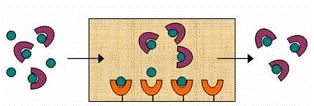Department of Chemistry
Document Type
Article
Date of this Version
1999
Citation
Clinical Chemistry 45:5, pp. 593–615 (1999)
Abstract
Affinity chromatography is a type of liquid chromatography that makes use of biological-like interactions for the separation and specific analysis of sample components. This review describes the basic principles of affinity chromatography and examines its use in the testing of clinical samples, with an emphasis on HPLCbased methods. Some traditional applications of this approach include the use of boronate, lectin, protein A or protein G, and immunoaffinity supports for the direct quantification of solutes. Newer techniques that use antibody-based columns for on- or off-line sample extraction are examined in detail, as are methods that use affinity chromatography in combination with other analytical methods, such as reversed-phase liquid chromatography, gas chromatography, and capillary electrophoresis. Indirect analyte detection methods are also described in which immunoaffinity chromatography is used to perform flow-based immunoassays. Other applications that are reviewed include affinity-based chiral separations and the use of affinity chromatography for the study of drug or hormone interactions with binding proteins. Some areas of possible future developments are then considered, such as tandem affinity methods and the use of synthetic dyes, immobilized metal ions, molecular imprints, or aptamers as affinity ligands for clinical analytes.
Included in
Analytical, Diagnostic and Therapeutic Techniques and Equipment Commons, Biochemistry, Biophysics, and Structural Biology Commons, Chemicals and Drugs Commons, Medicinal-Pharmaceutical Chemistry Commons



Comments
© 1999 American Association for Clinical Chemistry